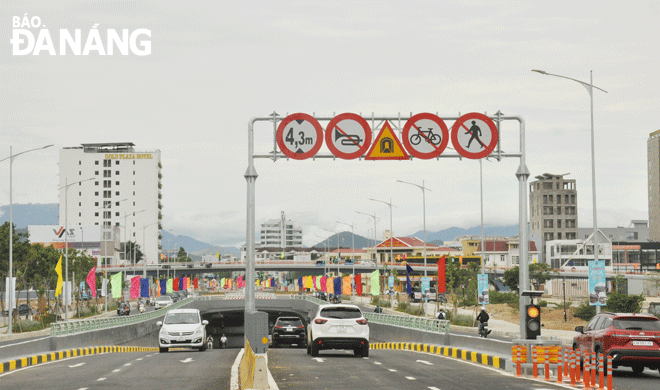Synchronous upgrade of traffic infrastructure to reduce congestion in inner-city
The Da Nang transport sector has made great efforts in upgrading and renovating the infrastructure system in a bid to significantly reduce congestion and facilitate traffic movement and economic trade.
 |
| The project to renovate the intersection at the western of the Tran Thi Ly Bridge has been put it into operation to reduce accidents and traffic jams. Photo: THANH LAN |
As a Vietnamese locality with a good traffic infrastructure system, Da Nang is still upgrading its grade separations which is the method of aligning a junction of two or more roadway axes at different heights (grades) so that they will not disrupt the traffic flow on other transit routes when they cross each other, as well as handle traffic accidents-prone spots city-wide.
Typically, the project to renovate the traffic infrastructures at the western end of Tran Thi Ly Bridge, one of the outstanding large-scale grade separations, has just been put into use, thereby making a positive contribution to eliminating congestion in the inner-city.
In July 2019, the Da Nang People’s Committee gave the green light to the upgrade of the Ngo Quyen - Ngu Hanh Son route with a cost of VND189.4 billion in order to limit road traffic accidents caused by tractors and trucks carrying freight in and out of the Tien Sa Port.
Under Phase 1 of this above-mentioned project, the upgrade of a 4.94km section of Ngo Quyen Street between the Nguyen Phan Vinh - Bui Quoc Hung intersection to its connection with Vo Van Kiet Street has reached completion .
Along with that, the city's transport sector has, over the past time, drastically implemented effective solutions to solve traffic jams in the inner-city with the renovation of many key intersections such as the construction of the Hue T-junction overpass, the Dien Bien Phu - Nguyen Tri Phuong grade separation and the at-grade intersections of Ton Duc Thang - Nam Tra, Nguyen Van Linh - Nguyen Tri Phuong, Nguyen Huu Tho - Le Dai Hanh, Nguyen Van Linh - Tran Phu, and September 2 - Xo Viet Nghe Tinh at the western end of the Tuyen Son Bridge, Nguyen Huu Tho - Xo Viet Nghe Tinh.
According to Vice Chairman of the municipal Bridge and Road Association Tran Dan, over the past time, many traffic infrastructure works in the city have been completed and put into use effectively, facilitating traffic connections and contributing to improving traffic capacity, meeting the growing travel needs of the people.
The ratio of land for traffic to average urban construction area has increased significantly.
However, in the coming time, it is a must-do for the city to manage infrastructure, organise scientific and reasonable traffic, make the most of the existing traffic network's capacity, enhance the quality and efficiency of the public passenger transport system, and set a limit to the use of private means of transport.
In particular, it is proposed that the national government soon commence the construction of the 11.5km Tuy Loan - Hoa Lien national highway section to facilitate the linkage with the Da Nang - Quang Ngai Expressway and La Son - Hoa Lien Highway.
Also, the building of a 6-lane bridge spanning the Han River at the Dong Da traffic node, connecting Hai Chau with Son Tra districts, should be taken into consideration as a way to reduce traffic volume for the already -overloaded Han River Bridge.
After 2025, the city needs to invest in the building of a tunnel through the Da Nang Airport, the extension of Nguyen Tat Thanh Street to the soon-to-be-developed Lien Chieu Port, in which the fourth Nam O Bridge crossing the Cu De River.
Currently, a number of key intersections in the inner-city during peak times present the risk of overloading, such as the intersection at the western end of the Rong (Dragon) Bridge and another one north of the Hoa Xuan Bridge, Le Quy Don - Trung Nu Vuong, Trung Nu Vuong - Nguyen Huu Tho and Ham Nghi - Ly Thai To intersections.
According to Deputy Director in charge of the Da Nang Department of Transport (Transportation) Bui Hong Trung, at the request of the municipal government, his agency is direct consulting units to carefully study the traffic arrangement of a intersection north of the existing Hoa Xuan Bridge, and the capital source for the expansion of the bridge and its approach roads.
In detail, focus will be expanding the bridge in tandem with constructing a tunnel along riverside Thang Long Street and a steel overpass along Cach Mang Thang Tam Street.
According to the Department of Transport, traffic congestion north of the bridge, exactly at the intersection of Le Thanh Nghi - Cach Mang Thang Tam - Thang Long – an approach road leading to the bridge, has appeared over the past years, especially during peak hours.
Through the survey, the longest vehicle queuing length is about 300 - 400m. Traffic through the intersection during peak hours is currently about 4,000 cars / hour, exceeding the capacity of the self-regulating intersection. Therefore, it is necessary to adjust the traffic arrangement at this cluster of traffic nodes in a bid to improve traffic movement.
For the intersection at the western end of the Dragon Bridge, adjustments will be made to the traffic organisation plan by signal lights to limit congestion in the immediate period.
Along with that, a facelift will be given to a transport infrastructure network with a focus on developing the public passenger transport system by 2030.
Reporting by THANH LAN - Translating by A.THU